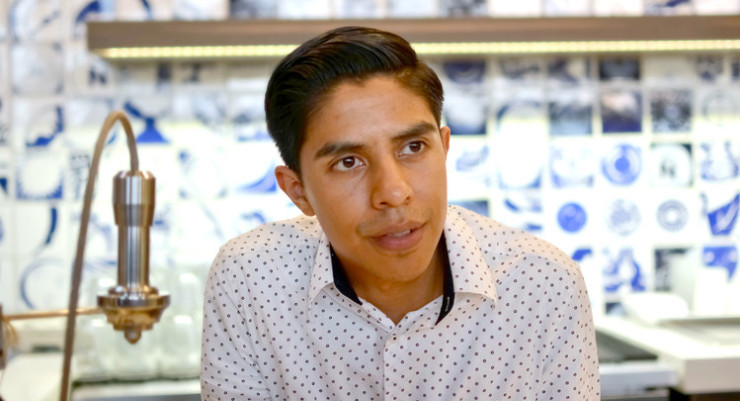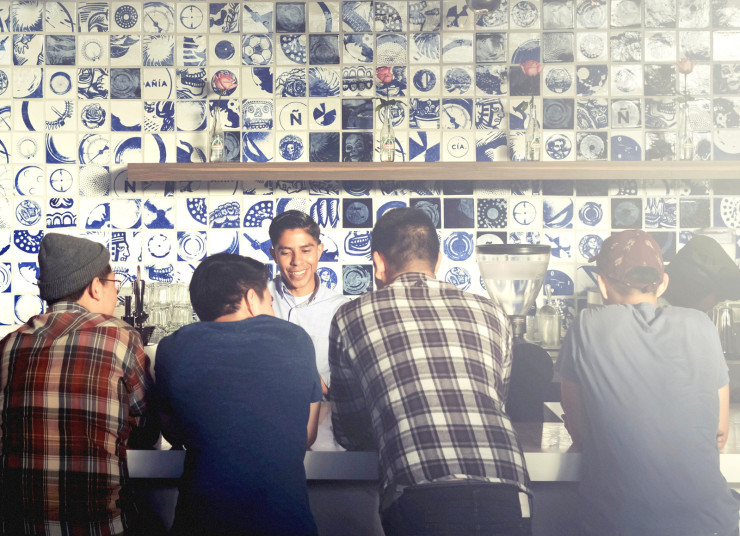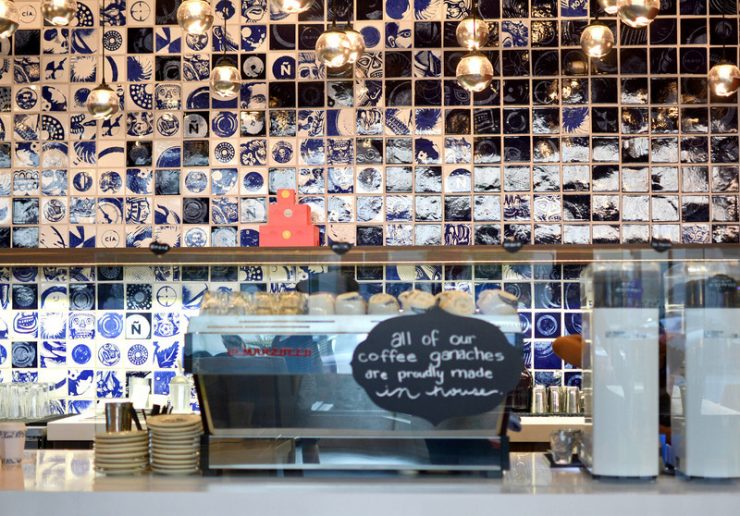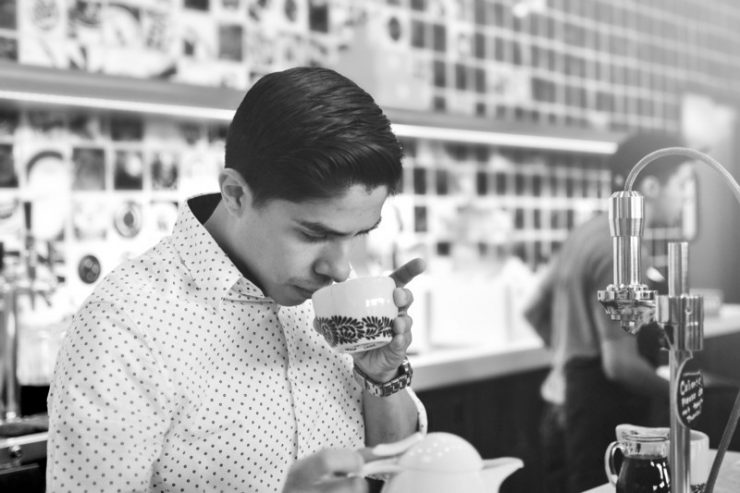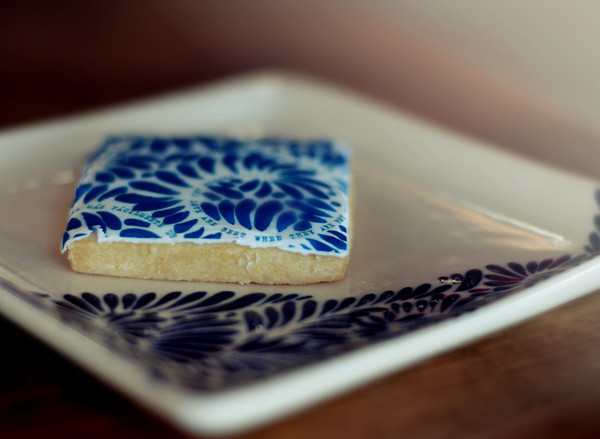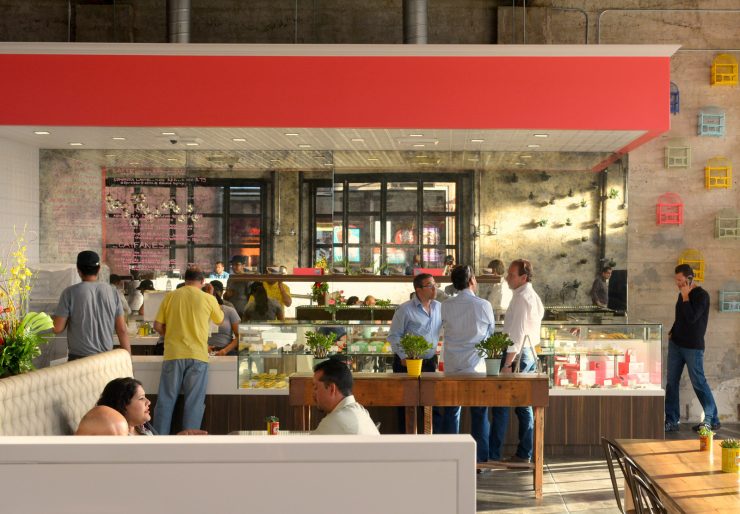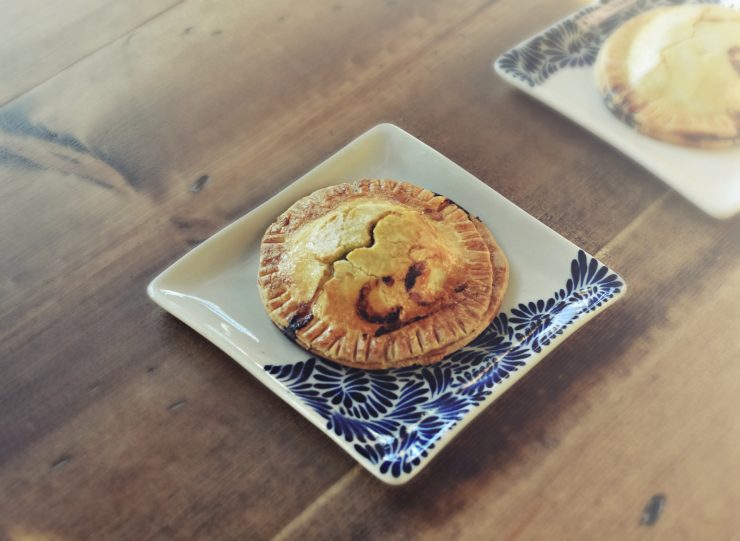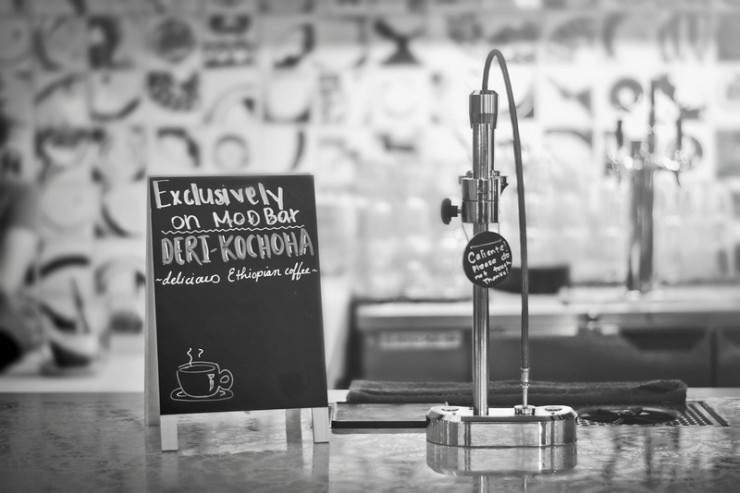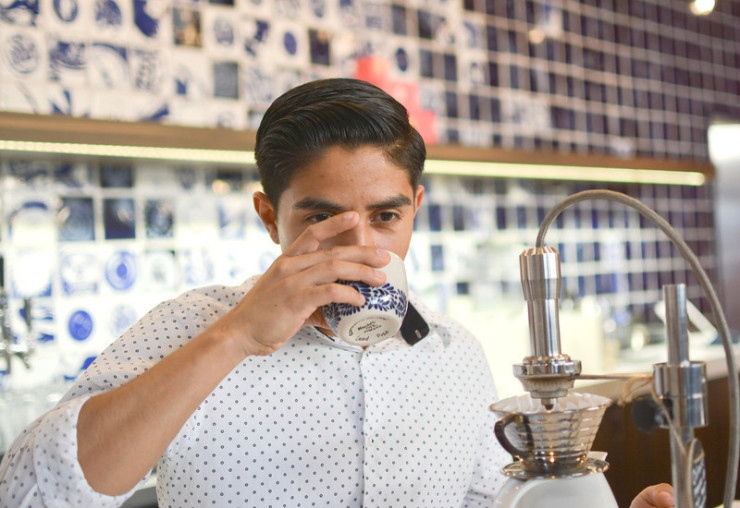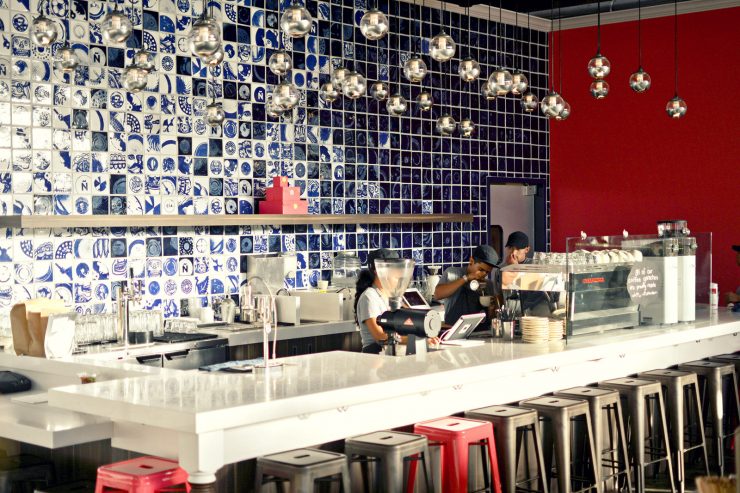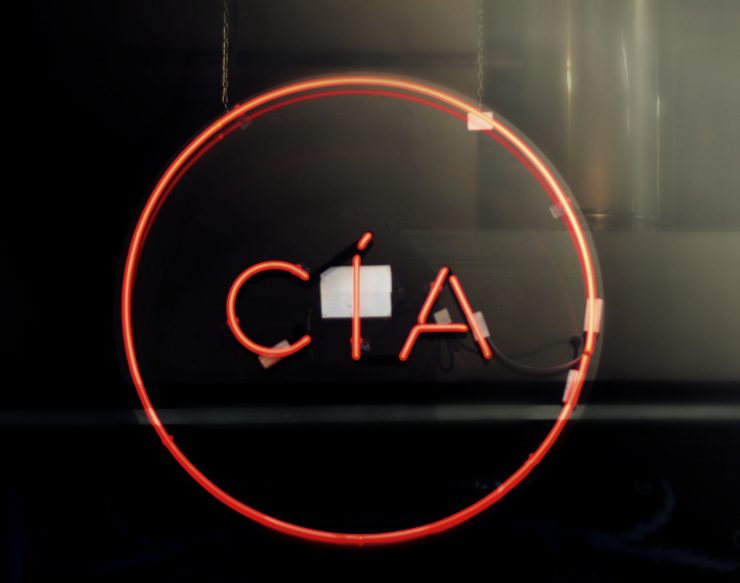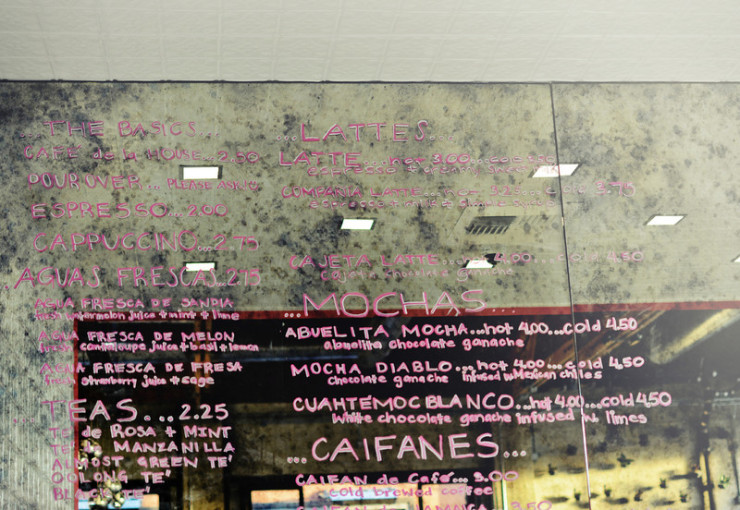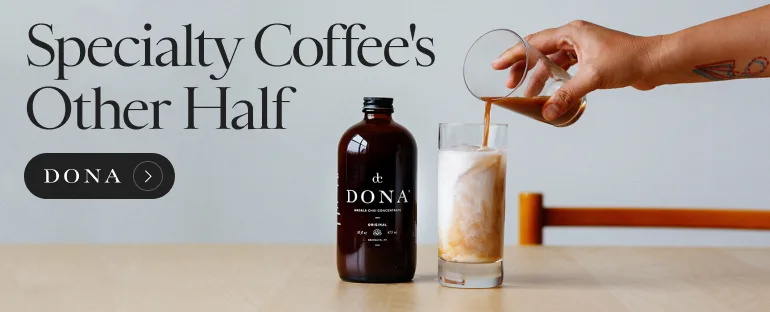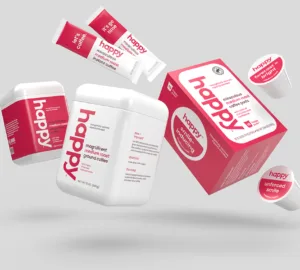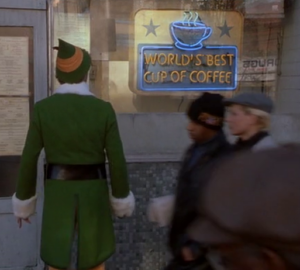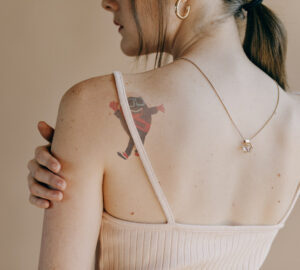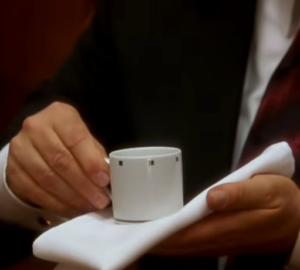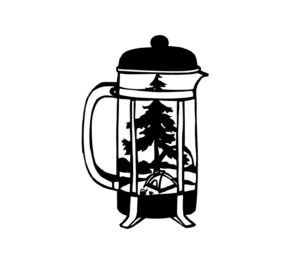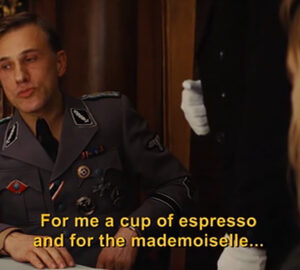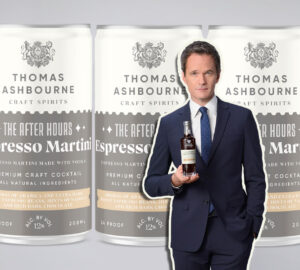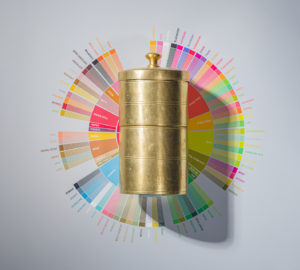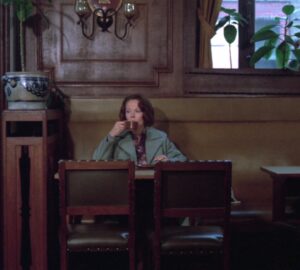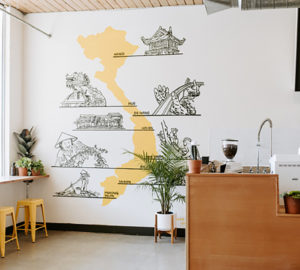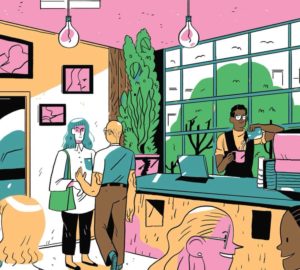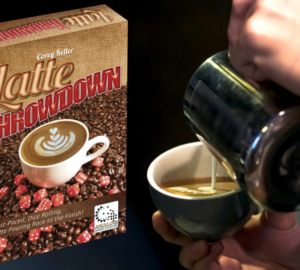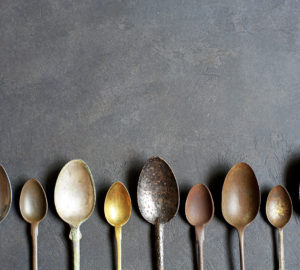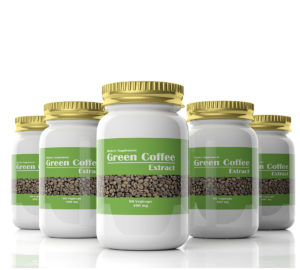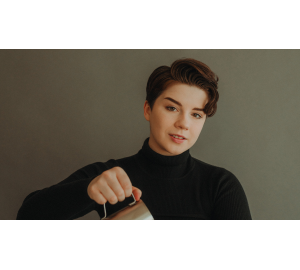Percy Ramirez has a posse.
The former Intelligentsia and G&B Coffee barista has been at the forefront of progressive coffee in Los Angeles for the last half-decade, working as a trainer and service professional with a glowing reputation in the community. In an industry that balances personality and performance like few others, Percy Ramirez’s work ethic, dedication to craft, and warm glow has made him well-liked by both peers and regulars. Mention his name to LA coffee lovers and pros alike, and you’ll get a smile in return.
So it was only a matter of time, then, before Mr. Ramirez had the opportunity to rise from lieutenant status to a star in his own right. That’s happened now at Compañía de Café, a new coffee bar in the city of San Fernando, located in northwestern Los Angeles County. Percy Ramirez is the Director of Coffee at Compañía, a “Mexican-American” cafe concept from owner Gaby Arvizu and noted chef Tamara Davis, formerly of Bottega Louie.
A glowing write-up on the LA Times food blog heralded opening week at Compañía. The project focuses on house-made pastries and delicious coffee at accessible prices, featuring top roasters like George Howell and Forty Ninth Parallel and modern coffee gear from La Marzocco and ModBar. The goal is to expose a whole new community to the wonders of specialty coffee, while creating a cafe space that feels uniquely homey and comfortable for a customer base not traditionally catered to by boutique cafe culture. In doing so, Mr. Ramirez & Co. have created a cafe that vibrates with possibility, turning on a whole new generation of coffee lovers in the process.
Percy Ramirez sat down with Sprudge via phone from Compañía de Café in San Fernando, for an interview accompanied by the work of noted Los Angeles photographer Amparo Rios.
So talk to us a little bit about the location for Compañía de Café.
We’ve been open for a little over two weeks, and there’s been no real big marketing push, so you know.
Which is something that happens quite often for new cafes in Los Angeles, the PR thing.
That’s right. But so, we’re out in San Fernando city. George Lopez came out of San Fernando city, but there’s really nothing out here, man. There’s a little shopping center a few blocks away, so if you need a quinceañera dress or a suit for you nephew’s baptism, that’s where you go.
Our busy times are from 6-10pm. It’s an entirely different cafe experience from Intelligentsia or G&B Coffee. At those cafes, the the life of the coffee bar happens in the mornings, but we’re busy late at night so far.
Are people drinking coffee at night?
Yeah, totally. Our menu is very accessible, so we have brewed coffee options, but really what people are coming in for are our ganaches. The abuelito ganache, our traditional Mexican chocolate, our spiced one, our white chocolate with lime. If that’s what people want, we’re gonna make the best we can and not use artificial stuff.
We’re selling a lot of iced coffee with tamarindo and jamaica–people will order that stuff at night. It feels like a bar, but it’s also very comfortable. We have like a little sala, which is like a hangout room or a salon, where everybody hangs out at home. There’s even a TV there right now for World Cup, of course.
The scene at night, who is it?
People after they’ve gone out to dinner, and also a lot of people who are also young, kids between 19 and their late 20s. This is their coffee shop. Before we opened, people had to drive a long ways from San Fernando to get coffee. There’s only one Starbucks here within a 5 mile radius. So I think for folks who live around here, they understand specialty coffee as a place for them to hang out.
Mexico City got shouted out as inspiration in the LA Times piece, but hey, you’re from Guatemala! How does that play in?
The whole vision for this project comes from Gaby Arvizu. She grew up here, went to school here, went to high school here, and then eventually went to Stanford and majored in urban planning. She came back to the neighborhood after graduating and started working with our project’s financial partners, and then this opportunity presented itself. The idea was to sort of bring back something into the community.
If you open up a WalMart here in San Fernando, people will embrace it. This neighborhood is full of people who’ll gladly drive out of their way for places like that, WalMart or Costco. Small business is important to this community, of course, but at the same time there is a very important sense of value. San Fernando is not a community that has a lot of capital, but they’re hard workers, man. So when it comes to buying their stuff, that’s what they do.
So the idea Gaby and the partners had was, they wanted to create something along the lines of not only a coffee shop, but potentially other concepts that people could appreciate on a higher scale. Something that’s a little more boutique than WalMart. She wanted to create a place where people could just be themselves, and not be intimidated. [laughs] I feel like everyone says that in coffee! Right, but I can relate to how that feels.
I have worked at places, where to be honest with you, we catered to people with money. These coffee shops sort of exuded, really just shined quality, but if I brought my family over…it’s not that they didn’t feel comfortable, they just didn’t connect with it the same way.
But you don’t have to be Mexican to come in here! I mean, I’m not Mexican.
But the influences are primarily from Mexico?
Yes, but not entirely. For example, the prints on our cups are very common in Latin America, not just Mexico. The partners, the way they talked to me, it’s like family–we’re all on the same page. Latinos really need something like this. It can’t just be $5 all the time.
But I did ask, “What about the rest of us? Is this project just a Mexican thing?” And they described it to me as like–it wouldn’t make sense to put the cultures together all in one way. If you get something wrong, you have to answer to that community. For example, an horchata drink in Mexico and El Salvador is COMPLETELY different, the texture and everything. For Gaby, this place was her vision, and she wants to share her culture, the Mexican culture. And I feel like I fit in. They’ve created an environment that’s comfortable for people to come in, and I connected with that.
Gaby was working in an industry before this that was mostly dominated by males, and she’s a woman, she’s young, and she’s Latina. And I’ve felt like that too; not just with coffee, but with everything. I look like I’m 14 years old, and I’m turning 30 next month! It’s hard to gain that respect when you’re young, and when you’re Latino, until a certain point, you’re not acknowledged until you prove your full potential.
So it doesn’t matter that I’m not Mexican at this cafe. I’m sort of proud, you know, that anyone can walk in here, any Mexican or any Latino or anybody! The feedback I’m getting is, “This is amazing! It feels like Mexico, it feels like home.”
Talk to us a little bit about chef Tamara Davis.
She was originally the pastry chef for Bottega Louie downtown, and the partners–there’s only like 3 main partners–spread the word and were looking for somebody who had experience in baking and chocolate-making. Tamara was definitely a lucky find. She came on board, and really just took hold of the whole menu. She basically just ripped it apart and put in her own two cents for everything from ingredients to pricing. A huge part of what she wanted to do was to push really high quality ingredients, which the partners have tried to balance with accessibility. It was a challenge to find a middle ground for that.
We have a full commissary in our space. Everything we serve is baked fresh daily on site. This commissary could potentially handle three additional stores. The intention is to grow and be big. It is a concept.
Many of our readers might not know you; can you share a bit of your background?
Sure! I was born in Guatemala and came to the US when I was 4. My mom and dad were very hard workers–my dad was a janitor, and my mom still is a housekeeper. Mom taught us the value of work from the get-go. I actually didn’t get my residency in the United States until I was about 19 years old, although had a work permit from 15 to 19. Growing up here truly was the American Dream, man. I was brought here for better reasons, grew up in Glendale, went to Glendale High School… it’s like the Wonder Years, man, growing up in the suburbs, walking home from school…I loved that.
But I knew from a certain point that I would have to work here. I didn’t have the documentation to go to university. I went to community college briefly, but didn’t finish, and started working at Porto’s, a Cuban bakery in Glendale. I started very young, working during the holidays. One of the owners, his name is Raul Porto, and the pastry chef, Tony Salazar, they were my mentors man. I came in and wanted to be a baker, but that wasn’t going to work out. I wasn’t experienced. But they were just opening up a cafe, had just expanded, so they sort of gave me the opportunity to run the coffee program. Raul was like “I want you to do some research, tell us what to do better,” and the more I did that, the more I realized we had to change a lot. And I ended up saying, “Hey, you’ve got to change all this stuff.” And they kind of looked at me like, ‘Hey, we’ve been doing this for 30 years, what are you talking about?’ But they sent me out to conventions to look at new equipment and stuff. That’s how I ended up meeting all these amazing people, the folks from Intelligentsia especially.
Back then there wasn’t a lot of information about coffee online. It became clear to me that Intelligentsia LA was where I wanted to work. If I wanted to learn about coffee, this was clearly the place where I could learn. So I walked into Silver Lake with an application probably 10 times, just openly telling them that I would be the dishwasher, anything to get in. And then finally, during the construction of Intelligentsia’s roasting works, [the green coffee exporter] Casey O’Keefe was there, and I walked into the roasting works, and he introduced himself and said, “Hey, I’m looking for a job.” He gave me a tour, and that was it. I was like, “OK, this is what I want to do.” He put me in touch with Kyle Glanville [then helping run Intelli LA]. This was during the 2009 Western Barista Championship regionals Intelli was hosting.
I walked up to Kyle and gave him my resume and said, “I’m ready.”
They were opening a new shop in Venice, and I got the gig. That was my first real coffee gig, 2009 at Venice. To this day, Kyle Glanville and Charles Babinski, those are my brothers. They pretty much taught me everything.
I went through my time with Intelli, and eventually worked for them as an educator out in their Pasadena store. That time in my life came to an end, and Kyle & Charles had opened up G&B Coffee at SQIRL, so that was it. It was an easy transition. They called me this time, and said, “Hey, if you’re looking for a job…”
To be honest with you, after I left Intelligentsia I wasn’t sure if I wanted to be in coffee again. A lot happens when you’re training people and it’s constant; you have to be constantly training yourself. There’s always something new to learn.
I was at G&B Grand Central when it opened, and that was amazing man. To see that service go into effect was awesome. If there was a place where i was truly happy just making coffee, that would be the place.
So how did Compañía find you?
Well like 2 years ago, I was doing a training at the roasting works with Intelli, and Gaby and one of the partners were there. They had been thinking about this for like 3 years, planning for a while, so they were touring the roasting works, introducing themselves, asking questions–“What’s the best machine? What’s the best grinder?”
And then a year later I’m at G&B and there they were, ordering coffee. They were there for about an hour, just hanging out. I just so happen to be having a conversation with one of our regulars about how I noticed how distant Latinos would get ordering from our bar. I noticed that most Latinos, they would walk up to the bar but give themselves a large amount of space. It was weird, trying to bring them in, give them a sample, and I couldn’t help but think that it was harder to sell to Latinos in this kind of coffee bar environment.
Gaby and the partner overheard me, and they were immediately just like, “it’s funny you say that.” That started a conversation about a bunch of stuff, and Gaby had remembered me from that tour of Intelligentsia. She told me they were working on a project–she was very minimal about it–but I remember her saying “it’s a Mexican-American concept.”
It was a perfect timing; we had just hired more people at G&B, and I felt like it was a great opportunity. I was happy at G&B; I was taken care of, there was no reason to leave, but at the same time I thought to myself, “what else do I want to do?” So I took a chance and I went.
What is your title at Compañía?
I’m director of coffee operations. I’m in charge of operations as well right now, a job I share with our general manager, Miguel Pozols. When I came on this was all super new to me. Coming up with menu, controlling costs, these are cafes tasks I’d never really done before. This is learning how to run a business. So I sat in an office for a good year! That was weird, but I learned so much.
So are you making coffees behind the bar, too?
Everything. I’m doing everything right now. Connie Mendoza, who used to work at Tierra Mia, she’s my second in command. And I also have Ingrid Morales, who’s another one of my coworkers, helping me form a core here. As we move on and open up new stores, they will be taking on more responsibility. Right now I oversee the floor, and I’ll jump on bar if I need to, but this is the least amount of time I’ve ever spent on bar. But it’s ok. It’s not a bad thing, you know? One thing I’ve learned is you have to, at a certain point, make somebody else responsibile so you can take a backseat and not have to kill yourself.
I’m a manager. I’m teaching my staff how to handle orders, handle this coffee bar. I’m still a trainer, and I’m on the bar, too. It’s fun, man.
Talk to us about the coffees you’re serving, which include 49th Parallel for espresso drinks and George Howell for filter.
Initially I wanted to work with Heart & Ritual, but those are some of the most expensive coffees you can buy. So we had a tasting of like 6 different roasters and ended up liking 49th for what it was: it’s a clean, sweet espresso, very easy to work with. For George Howell, I had a really positive experience with their coffees at TED, and they were accessible as well. These two roasters are some of the best and most accessible.
We’re using the 49th Parallel Epic blend for espresso, which I was first exposed to through G&B. We also have some Intelligentsia single origin coffees, including La Perla from Oaxaca, which is just stellar man. “Just coffee” in San Fernando is kind of hard to sell–nobody has been exposed to that stuff, so that’s something we’re working on. But people come in and they’re like “Oh, coffee from Mexico!” It just sells itself–to have that name on the menu, it’s like, ok, that’s an easy sell. We just put it on the menu Monday, so we’ll have an entire week to see how it plays out. It’s exciting. We also have coffees from George Howell that really highlight how delicious Ethiopian coffees can be, and we’re selling them at a price point that’s crazy good. I’m talking really good coffee for like $3.50 or $3.75. We can do that because we can do that, you know?
Tell us about the carbonated cold brew.
Basically the original idea was like, ok, let’s make some aguas frescas! One of the places Gaby and the partners traveled to was Passmar in Mexico City. They sort of explained to me how they went to visit and had all these interesting recipes. Something that was sweet, but very rich with coffee flavor, and a message behind the drink. They fell in love with that stuff.
So when they came to me and said you know, we want to make coffee and blend that with an agua fresca. And I was like–“Oh God…”–because you know, it’s so hard to mix coffee with anything and have it taste good. It’s the most challenging thing about a signature drink in barista competitions. But we wanted to make this feel like a bar–so what can we do to mix coffee with something sweet?
My idea was, ok, let’s make an iced coffee, then combine it with something that’s the other extreme. Let’s use something that’s super tart and acidic, and the sugar is gonna help, and the carbonation is gonna help. The carbonation was an accident, actually. I mixed tamarindo with iced coffee but instead of putting regular water in I put the bubbly stuff, and everyone loved it. It wasn’t perfect, but it was an inside joke, you know–how much lime are you going to add to any product to make it Mexican enough?
The idea of putting it in a keg was easy. It reemphasizes the whole bar concept. We take two very common aguas frescas–tamarindo and jamaica–and combine them with iced coffee.
The LA Times piece mentions that you’ve hired a staff of 60 folks–that’s a lot! What are all those people doing? [laughs] Yeah man! The majority of the staff is back of the house. We have a full pastry team in the back, and that’s where you see the majority of staff. We have around 12 people working up front in the bar, and the rest are slaving away in the back, working through 3 shifts a day. We’re open to the public from 6am to 11pm, and we have people coming in at 3am for baking and prep. That’s where the majority of the labor is coming from. Right now 80% of our staff lives within walking distance of our shop in San Fernando, which is a huge thing for us.
We staffed up because we have a second location coming. Construction will start next week. A lot of the people we have here, we’re anticipating to have them ready for the next store.
Tell us more about this second location.
It’s going to be around the same size as our flagship, minus the commissary kitchen. Front of house will resemble a lot of the same themes we have here in San Fernando. The intention is for us is to open in communities that are heavily Latino–to give these communities a place where they’re at home, this is their coffee shop.
Our second location will be in South Gate, just north of Long Beach. It’s one of the most densely populated Mexican communities in southern California, but it has more of an industrial vibe. We’ll be on the outskirts of one of the shopping centers, 3 stores down from an In & Out.
Within the wider context of coffee in LA, where does your new project fit? Are you guys trying to be everyday specialty for a new community? Are you trying to democratize specialty coffee?
I think a lot of people will and are going to compare us to the big corporate coffee shops, like Starbucks & Coffee Bean & Tea Leaf, because if we open in places where that’s all that’s accessible, that’s the easiest way to compare who we are and what we’re doing. But in terms of service, coffee, preparation, that all fits within the mold of specialty that’s happening in downtown or the arts district–it’ll essentially be the same thing. I’ve had friends come by, and one of the most exciting things for me is seeing people I’ve worked with before, and their initial reaction. These are the people who will be the most honest about the coffee, but the first thing that comes out of their mouth is “Jesus, it’s so nice here!” And the coffee is awesome, but my coffee friends are ordering the ganaches, the mochas, and I wasn’t expecting them to do that. But at the same time, that’s what we’re going to be known for. So if we get compared to Starbucks or Coffee Bean & Tea Leaf, I think people can say that, but we’re on another level as far as quality is concerned.
I ultimately want this cafe to open up new windows. It’s a great opportunity to introduce specialty coffee to a community that didn’t even know it existed. It’s harder to sell folks in San Fernando regular coffee, or even my own family, because they’re so used to something plain and common, like Nestle or Folgers, so your best bet is to sell them on the house-made ganache. We’re using Strauss milk, and when people order a cup of milk, they’re like, “Oh God, that’s amazing!”
I forget how uncommon these things are outside of downtown. It’s exciting to see people get excited about milk again, and about the way we’re making the coffee. There’s so much life here, all kinds of people, neighborhood folks but also bloggers and writers who live out here in the valley. They all have to drive downtown everyday for what they do; we’ve had a lot of people come in and say thanks for putting this out there. And that means so much, you know?
I think that’s all anyone wants to see when they’re serving great coffee or food: they want people to appreciate it. It feels like us.
Photos by Amparo Rios, used by permission.











